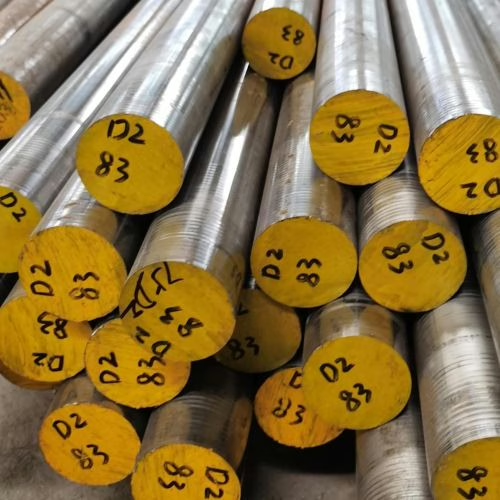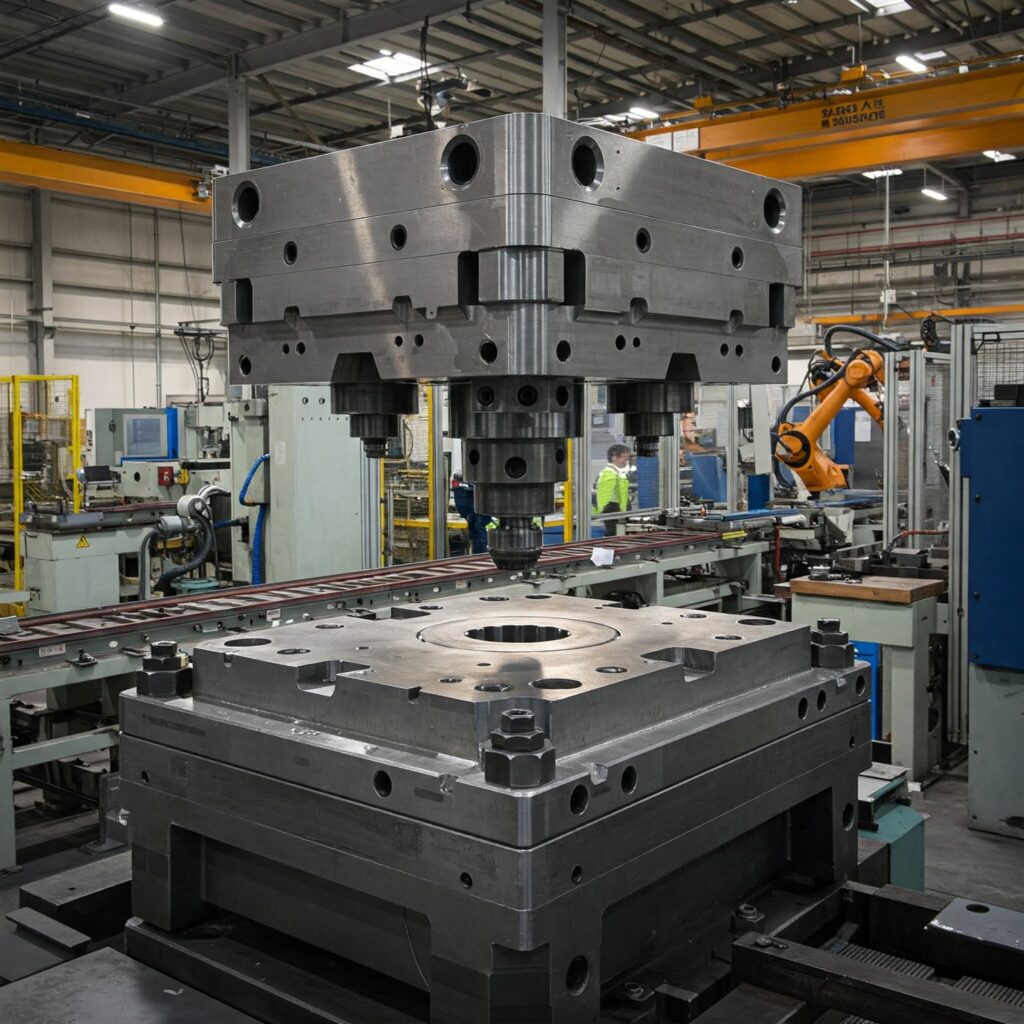Szacowany czas czytania: 7 minut
Najważniejsze wnioski
- O1 tool steel and D2 are both cold-work tool steels, but they have distinct chemical compositions and applications.
- O1 exhibits better machinability and higher toughness, while D2 offers superior wear resistance and dimensional stability.
- In terms of heat treatment, O1 is oil-hardening and prone to cracking, whereas D2 is air-hardening with minimal deformation risks.
- Applications of O1 include general purpose tools, while D2 is preferred for high-wear tooling requiring prolonged usage.
- Selecting between O1 tool steel Vs D2 depends on whether you prioritize ease of machining or enhanced wear life.
Spis treści
Stal narzędziowa O1 kontra D2: Stal narzędziowa O1 I Stal narzędziowa D2 Obie stale narzędziowe do pracy na zimno są powszechnie stosowane, ale posiadają różne właściwości, które czynią je odpowiednimi do różnych zastosowań. Szczegółowe porównanie ujawnia ich mocne i słabe strony.


O1 tool steel Vs D2: Chemical Composition
| Element | Stal narzędziowa O1 (%) | Skład stali D2 (%) |
| Węgiel (C) | 0.85 – 1.00 | 1.40 – 1.60 |
| Chrom (Cr) | 0.40 – 0.60 | 11.00 – 13.00 |
| Mangan (Mn) | 1.00 – 1.40 | 0.10 – 0.60 |
| Wanad (V) | 0.15 – 0.30 | 0.50 – 1.10 |
| Molibden (Mo) | – | 0.70 – 1.20 |
| Wolfram (W) | 0.40 – 0.60 | – |
| Krzem (Si) | 0.10 – 0.50 | 0.10 – 0.60 |
| Fosfor (P) | ≤ 0,03 | ≤ 0,03 |
| Siarka (S) | ≤ 0,03 | ≤ 0,03 |
O1 tool steel Vs D2: Mechanical Properties
- TwardośćStal O1 i stal D2 mają podobną twardość roboczą. Typowa Twardość stali O1 wynosi 58–60 HRC. Twardość stali D2 wynosi 58–61 HRC i może osiągnąć 60–62 HRC poprzez obróbkę cieplną, a nawet 63–64 HRC w przypadku produkcji metodą metalurgii proszków (P/M). Ogólnie rzecz biorąc, Stal O1 twardość Rockwella jest nieznacznie niższy niż D2.
- Wytrzymałość. O1 has a yield strength of 829 MPa (758 MPa UTS). Its compression yield strength was higher than that of D2 steel. The yield strength of D2 is 411 MPa (350 MPa UTS), and the tensile strength (UTS) is 758 MPa.
- WytrzymałośćW porównaniu z O1, stal D2 ma niższą wytrzymałość. Duża zawartość węglików w stali D2 zmniejsza jej wytrzymałość.
- Ciągliwość/PlastycznośćStal O1 charakteryzuje się wyższą ciągliwością niż stal D2. Stal O1 wykazuje znaczne zwężenie przed pęknięciem, z obliczoną redukcją powierzchni wynoszącą około 19,7%. Stal D2 nie wykazała prawie żadnego zwężenia przed pęknięciem, ze redukcją powierzchni wynoszącą 1,3%.
- Odporność na zużycie/ścieranie. D2 has better wear resistance compared to O1. O1 steel has moderate wear resistance, while D2 steel has very high wear resistance. This is because the high carbon and chromium content in D2 steel produces a large amount of M7C3-type chromium-rich carbides.
- Stabilność wymiarowa/zniekształcenieW porównaniu z innymi stalami narzędziowymi, stal D2 charakteryzuje się najlepszą stabilnością wymiarową podczas obróbki cieplnej, chociaż stal O1 wykazuje również minimalne zmiany wymiarów podczas hartowania w oleju. Stal D2 jest hartowana głównie na powietrzu, z rozszerzeniem lub skurczem wynoszącym około 0,0005 cala na cal.
- Skrawalność/szlifowalnośćStal O1 charakteryzuje się doskonałą skrawalnością, wynoszącą 90 w porównaniu do 100 w przypadku stali węglowej 1%. Stal D2 jest szczególnie słaba pod względem skrawalności, osiągając wynik 45 w porównaniu do 100 w przypadku stali węglowej 1%. Oczywiście stal O1 charakteryzuje się znacznie lepszą skrawalnością.
Heat Treatment Comparison
O1 is an oil-hardening steel, also known as oil-quenched steel, which is rapidly immersed in oil for cooling after being heated to the austenitizing temperature. This rapid oil-cooling process subjects the steel to significant thermal shock. Consequently, O1 presents moderate quenching safety risks during hardening, being prone to cracking due to thermal shock and relatively large dimensional changes or deformation risks. Compared to air-hardening steels, O1 exhibits poorer dimensional stability. Expansion during quenching is estimated at approximately 0.0015 mm/mm. Additionally, O1 is prone to decarburization during heat treatment, where surface carbon content is lost, resulting in insufficient surface hardness.
D2 is a wind-hardening steel, also known as air-hardening steel. When cooled from its austenitizing temperature, it achieves its full hardness simply by cooling naturally in still air. Because D2 contains a high proportion of alloying elements, these elements significantly slow the rate of microstructural transformation within the steel. Air cooling is an exceptionally slow and gentle cooling process. Consequently, D2 exhibits exceptionally high safety during hardening and is extremely resistant to cracking. During heat treatment, D2 demonstrates minimal deformation, with a very low expansion or contraction rate of approximately 0.0005 mm/mm. Due to its outstanding dimensional stability, D2 is the material of choice for manufacturing precision molds with complex geometries and extremely tight tolerances.
| Funkcja | Obróbka cieplna stali O1 | Obróbka cieplna stali D2 |
| Temperatura hartowania/austenityzacji | 802–816 °C (1475–1500 °F) | 1010–1024 °C (1850–1875 °F) |
| Medium hartujące | Hartowanie w oleju. Osiąga pełną twardość po zahartowaniu w oleju. | Hartowanie głównie w powietrzu. W przypadku cięższych profili może być konieczne hartowanie w oleju. |
| Odpuszczanie | Zazwyczaj hartowane w temperaturze 149–232 °C (300–450 °F). | Hartowanie w niskich temperaturach, około 200 °C (392 °F), w celu uzyskania dużej twardości. |
| Odwęglanie i pękanie | Ulega odwęgleniu podczas obróbki cieplnej i jest podatny na pękanie wskutek szoku termicznego podczas hartowania w oleju. | D2 charakteryzuje się wysoką odpornością na pękanie podczas formowania i obróbki metalu. |
Mechanical Behavior and Fracture Characteristics
A study investigating the plasticity and ductile fracture behavior of locally manufactured O1 and D2 cold-work tool steels under monotonic quasi-static tensile and compression tests highlighted significant mechanical differences.
| Własność | O1 Stal narzędziowa | Stal narzędziowa D2 |
| Tensile Yield Strength | Higher (829 MPa) | Lower (411 MPa) |
| Compression Yield Strength | Wyższy | Lower |
| Necking Behavior | Vivid necking prior to fracture | Almost no necking prior to fracture |
| Area Reduction at Fracture | High (19.7%) | Low (1.3%) |
| Tryb pęknięcia | Cup–cone fracture mode | Flat-surface fracture mode |
In this specific study, O1 demonstrated higher tensile yield strength and ultimate tensile strength compared to D2. Conversely, O1 exhibited characteristics of high metal softening beyond the UTS, evident through clear necking and a high area reduction at fracture (19.7%), resulting in a cup-cone fracture surface.
D2, while having slightly higher ductility and toughness noted in the context of alloying elements (Mo, V, Cr), demonstrated virtually no necking and a much lower area reduction (1.3%), leading to a flat-surface fracture mode.
Applications and Machinability
Choosing between O1 and D2 comes down to prioritizing either simplified manufacturing or extended service life in demanding applications.
Machinability refers to how easily steel can be cut or formed in its annealed state. This property is primarily inversely proportional to its internal carbide content. O1 possesses excellent machinability. It receives a high machinability rating of 90, with 1% carbon steel serving as the 100 benchmark. Its low alloy content, particularly the near absence of hard carbides within its structure, makes cutting exceptionally easy. D2, however, is extremely difficult to machine and grind. Due to its extremely high carbon and chromium content, the steel is filled with large quantities of high-hardness abrasive carbides, much like grit in sandpaper. This results in a very low machinability rating of 45. D2’s notoriously “tough-to-handle” nature has even earned it the nickname “dog” among some toolmakers, implying it’s particularly troublesome.
- O1 Applications: As an “old workhorse general purpose steel”, O1 is widely used for smaller tools and dies, especially where good machinability and an excellent balance of toughness and hardness are required. Typical applications include blanking dies, coining dies, forming dies, gauges, and certain machine parts (e.g., bushings, cams, guides).
- D2 Applications: D2 is the industry standard for cold-work tooling applications demanding long runs and high wear resistance. It is particularly preferred for long-duration fabrication processes where its high resistance to wear and dimensional stability minimize downtime. Applications include piercing punches and dies, long-run blanking dies (often used for mass production of steel and other metals), and thread-rolling dies.
Making the Selection
D2 represents ultimate dimensional stability and superior wear resistance. O1, on the other hand, offers greater toughness and easier machinability.
When your application prioritizes maximizing wear life and minimizing heat treatment distortion, D2 is the obvious choice. Its high carbon and chromium content forms exceptionally durable carbides, making it the ideal material for high-volume, long-cycle continuous operation dies. Despite its challenging machinability and inherently lower toughness, its outstanding dimensional stability and wear resistance are unmatched by O1.
O1 is the go-to choice for general-purpose. When applications prioritize excellent machinability, lower cost, and higher toughness, O1 is the preferred choice. It is better suited for manufacturing small to medium-sized tools or parts requiring a perfect balance of hardness and toughness while also being easy to machine. Although its wear life is not as long as D2’s, and there is a certain risk of distortion (warping) and cracking during oil quenching, its overall balance is outstanding.


